全文HTML
--> --> -->因此, 与上述研究方法(OA-ICOS, CW-CRDS, DE-OFC)以及中红外DAS技术不同, 本文采用免标定、高信噪比的WM-DAS方法结合Herriott池[11]以实现大气痕量气体的监测. 利用该方法在常压常温条件下, 测量了大气中CO2 6330.821 cm–1以及CH4 6046.964 cm–1两条谱线, 在1 s的时间内, 光谱拟合的残差标准差分别达到5.6 × 10–5和7 × 10–5. 随后, 采取WM-DAS与CW-CRDS分时测量的方式, 对大气中CO2和CH4进行了连续监测, 并分析了两种方法的探测下限. 实验结果表明两种方法对大气中CO2及CH4测量结果一致, 两组数据的线性拟合相关性达到0.99, 其中, 基于WM-DAS方法的CO2和CH4的检测限分别达到170 ppb和1.5 ppb, 略高于CW-CRDS检测限, 但测量速度远高于CW-CRDS.
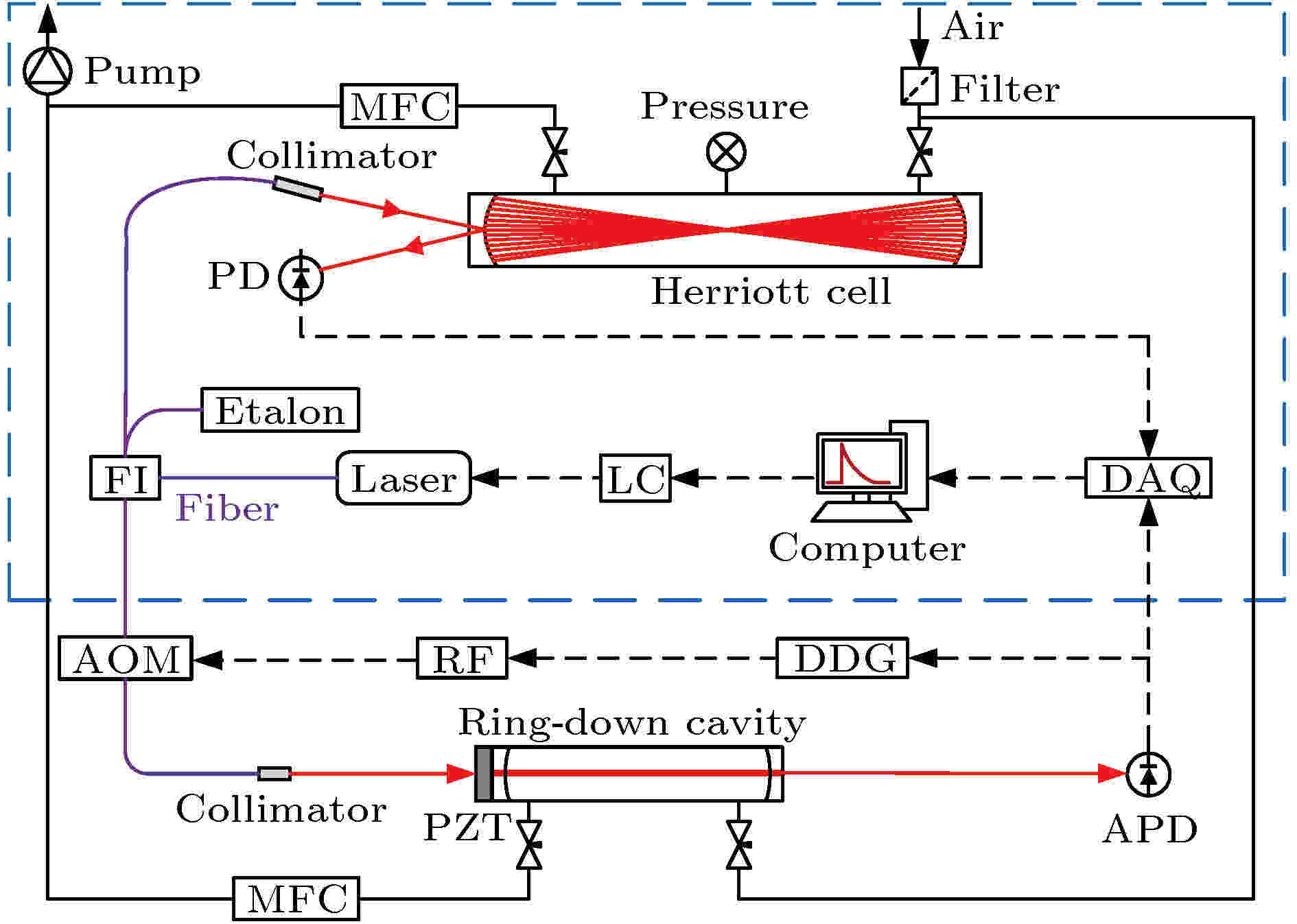 图 1 WM-DAS与CW-CRDS的系统原理图(LC, 激光电流和温度控制器; FI, 光纤隔离器; AOM, 声光调制器; APD, 雪崩光电二极管; PD, 光电二极管; DDG, 数字延迟发生器; PZT, 压电换能器; RF, 射频发生器; DAQ, 数据采集系统; WM, 波长计; MFC, 质量流量计)
图 1 WM-DAS与CW-CRDS的系统原理图(LC, 激光电流和温度控制器; FI, 光纤隔离器; AOM, 声光调制器; APD, 雪崩光电二极管; PD, 光电二极管; DDG, 数字延迟发生器; PZT, 压电换能器; RF, 射频发生器; DAQ, 数据采集系统; WM, 波长计; MFC, 质量流量计)Figure1. System schematic diagram of WM-DAS and CW-CRDS. LC, laser current and temperature controller; FI, fiber isolator; AOM, acousto-optic modulator; APD, avalanche photodiode; PD, photodiode; DDG, digital delay generator; PZT, piezoelectric transducer; RF, radio frequency; DAQ, data acquisition system; WM, wavelength meter; MFC, mass flow controller.
3.1.WM-DAS
与DAS法[4-7] (三角波)和WMS法[19-21] (三角波+正弦波)不同, WM-DAS[18]法仅采用频率为ω的正弦信号扫描分子吸收谱线, 其激光光强I可以由下式来描述: 图 2 激光频率标定以及FFT滤波 (a) 干涉仪信号(黑色实线), It (蓝色实线), 测量(黑色实心圆)以及拟合的相对频率(红色实线), 拟合残差(红色空心圆); (b) It的傅里叶系数的实部A (红色)与虚部B (蓝色), 低频噪声(0.35, 0.45 kHz)和高频噪声(499.7, 514.1 kHz)
图 2 激光频率标定以及FFT滤波 (a) 干涉仪信号(黑色实线), It (蓝色实线), 测量(黑色实心圆)以及拟合的相对频率(红色实线), 拟合残差(红色空心圆); (b) It的傅里叶系数的实部A (红色)与虚部B (蓝色), 低频噪声(0.35, 0.45 kHz)和高频噪声(499.7, 514.1 kHz)Figure2. Laser wavelength calibration and FFT filtering: (a) Etalon signal (black solid line), It (blue solid circle), measured (black solid circle) and fitted relative frequency (red solid line), fitting residual (red hollow circle); (b) real part and imaginary part of Fourier coefficients of It, and low frequency (0.35, 0.45 kHz) and high frequency (499.7, 514.1 kHz) noise.
在实际应用中, 激光强度波动、颗粒浓度和噪声会显著影响吸收率函数的测量精度[8,9]. 图2(b)显示了具有100个周期的正弦波(频率1 kHz)的透射光的傅里叶系数Ak和Bk, 可以清晰看到, 在特征频率(1 kHz, 2 kHz, ···)以外存在着其他频率的噪声. WM-DAS方法只采用特征频率重构光强, 因此可以很容易消除0.35, 0.45 kHz的低频噪声(如环境电磁干扰)和499.7, 514.1 kHz的高频噪声(如光的干涉), 进而提升信噪比.
随后, 将WM-DAS和CW-CRDS气室联通, 气室内充入干燥空气至100.9 kPa. 采用WM-DAS法对CO2 (6330.821 cm–1)和CH4 (6046.964 cm–1)分子两条近红外吸收谱线的吸收率函数进行了静态测量, 采集(0.1 s)和处理共用时约1 s, 谱线参数取自HITRAN数据库[26]. 由于CH4 (6046.964 cm–1)谱线附近有两条次强的CH4谱线6046.952和6046.943 cm–1, 为此本文采用三峰拟合的方式拟合吸收率函数. 如图3所示, 在常温常压下, ± 0.55 cm–1波长范围内, CO2和CH4光谱的吸收峰值分别为0.93%和1.05%, 残差标准差分别为5.6 × 10–5和7 × 10–5, 接近于短光程(< 1 m)和低压下的测量结果(4.9 × 10–5)[18]. 将吸收率转换为吸收系数后得到的残差标准差分别为4.4 × 10–9和5.5 × 10–9 cm–1, 接近于CEAS和CRDS测量结果[12-15].
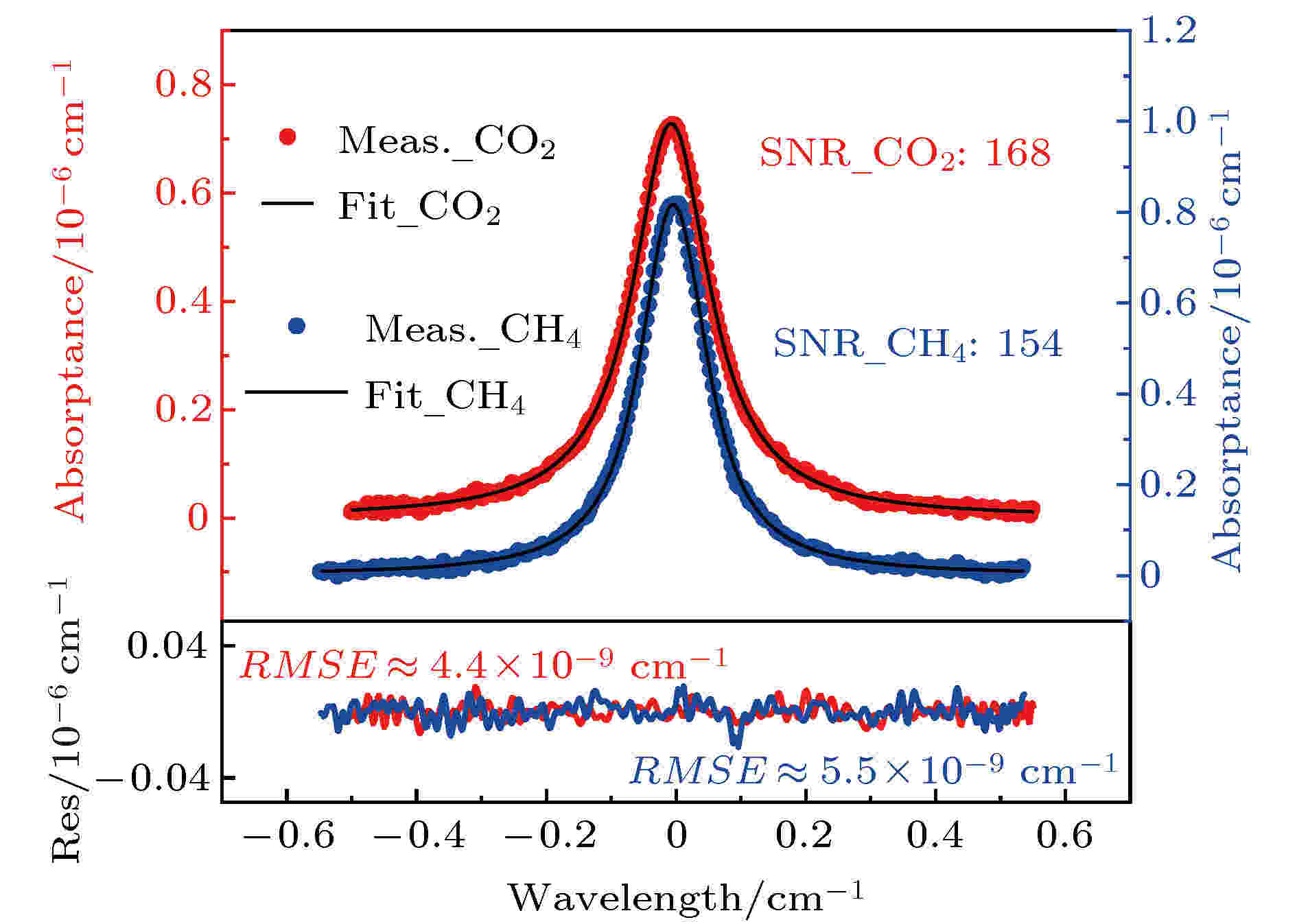 图 3 采用WM-DAS方法在298 K, 100.9 kPa下所测的CO2 (红色)和CH4 (蓝色)吸收光谱, 以及Voigt拟合, 用时约1 s (为方便与CW-CRDS比较, 将吸收率转换为吸收系数(cm–1))
图 3 采用WM-DAS方法在298 K, 100.9 kPa下所测的CO2 (红色)和CH4 (蓝色)吸收光谱, 以及Voigt拟合, 用时约1 s (为方便与CW-CRDS比较, 将吸收率转换为吸收系数(cm–1))Figure3. Absorption spectra of CO2 (red) and CH4 (blue) measured by WM-DAS in about 1 s at 298 K and 100.9 kPa, and the best fit of Voigt profile. In order to compare with CW-CRDS, the absorptance is converted to absorption coefficient (cm–1).
2
3.2.CW-CRDS
在CW-CRDS中, 吸收系数(κ)与衰荡时间(τ)存在如下关系[23,24]:实验中采取连续扫描激光电流的方式来改变激光波长, 同时高速扫描腔长以使任意波长的激光均能与腔模式耦合[27], 从而得到周期性的、蕴含气体吸收的衰荡时间信号, 对该信号采用平均或者傅里叶滤波的方式以提高信噪比, 最终可得到衰荡时间τ与激光电流i的关系, 如图4(a)所示. 由于采用连续扫描激光电流的方式, 因此激光相对波长v可采用标准具进行标定, 从而得到v与i的关系. 最后, 根据电流i可建立起衰荡时间τ与相对波长v的关系τ(v), 再结合(7)式, 即可得到吸收系数κ(v), 对其拟合[23,24]可得到气体的光谱参数(如温度、浓度等).
 图 4 采用CW-CRDS在298 K, 100.9 kPa下测量的CO2 (红色)和CH4 (蓝色)两条谱线(用时约24 min) (a) 衰荡时间与电流的关系; (b) 吸收率函数及其Voigt拟合
图 4 采用CW-CRDS在298 K, 100.9 kPa下测量的CO2 (红色)和CH4 (蓝色)两条谱线(用时约24 min) (a) 衰荡时间与电流的关系; (b) 吸收率函数及其Voigt拟合Figure4. The absorption spectra of CO2 (red) and CH4 (blue) measured by CRDS in about 24 min at 298 K and 100.9 kPa: (a) The relationship between the ring down time and the current; (b) the absorption function and the best fits of Voigt profile.
如3.1节所述, CW-CRDS与WM-DAS气室联通, 在两气室的温度和压力相同的条件下, 采用CW-CRDS方法对CO2 (6330.821 cm–1)和CH4 (6046.964 cm–1)两条谱线进行了静态测量. 在两条谱线附近 ± 3 cm–1范围内, 水谱线的线强度比两条谱线小4个数量级以上, 且气体经过干燥后水的浓度可低至100 ppm (1 ppm = 1 mg/L). 每个分子的光谱测量时间约24 min, 光谱的平均次数为100次, 并采用Voigt线型函数进行拟合. 如图4(a)所示, 实验中6330.821与6046.964 cm–1处的镜片反射率不同, 空腔衰荡时间分别约为56和15.5 μs, 中心波长处衰荡时间分别约为25和11.5 μs, 因此CO2光谱信噪比更高. 图4(b)中光谱拟合的残差标准差7 × 10–10 cm–1 (CO2)及1.6 × 10–9 cm–1 (CH4)与文献[12—15]结果一致, 分别为图3中WM-DAS方法的3倍和6倍, 但CW-CRDS (约24 min)所用时间远大于WM-DAS (约1 s).
2
3.3.两种方法对比分析
如图5(a)所示, 随着气体浓度的升高, 在中心波长处, 衰荡时间减小导致衰荡信号的采样点减少, 以及腔的出射光强减弱[27], 均会降低CW-CRDS信噪比, 增大测量的离散度(如图5(b)所示). 长光程的WM-DAS出射光信号强, 不受光强减弱影响, 信噪比与气体浓度正相关, 且浓度上限更高, 量程范围大. 这表明CW-CRDS方法最适合低浓度的区域A, 在较低浓度的区域B, 两种方法测量结果一致. 大气中CH4的含量(约1.7 ppm)处于区域B, 两种方法均可测量, 但长光程WM-DAS测量速度(0.1 s)更快、系统简单, 更适合在线监测.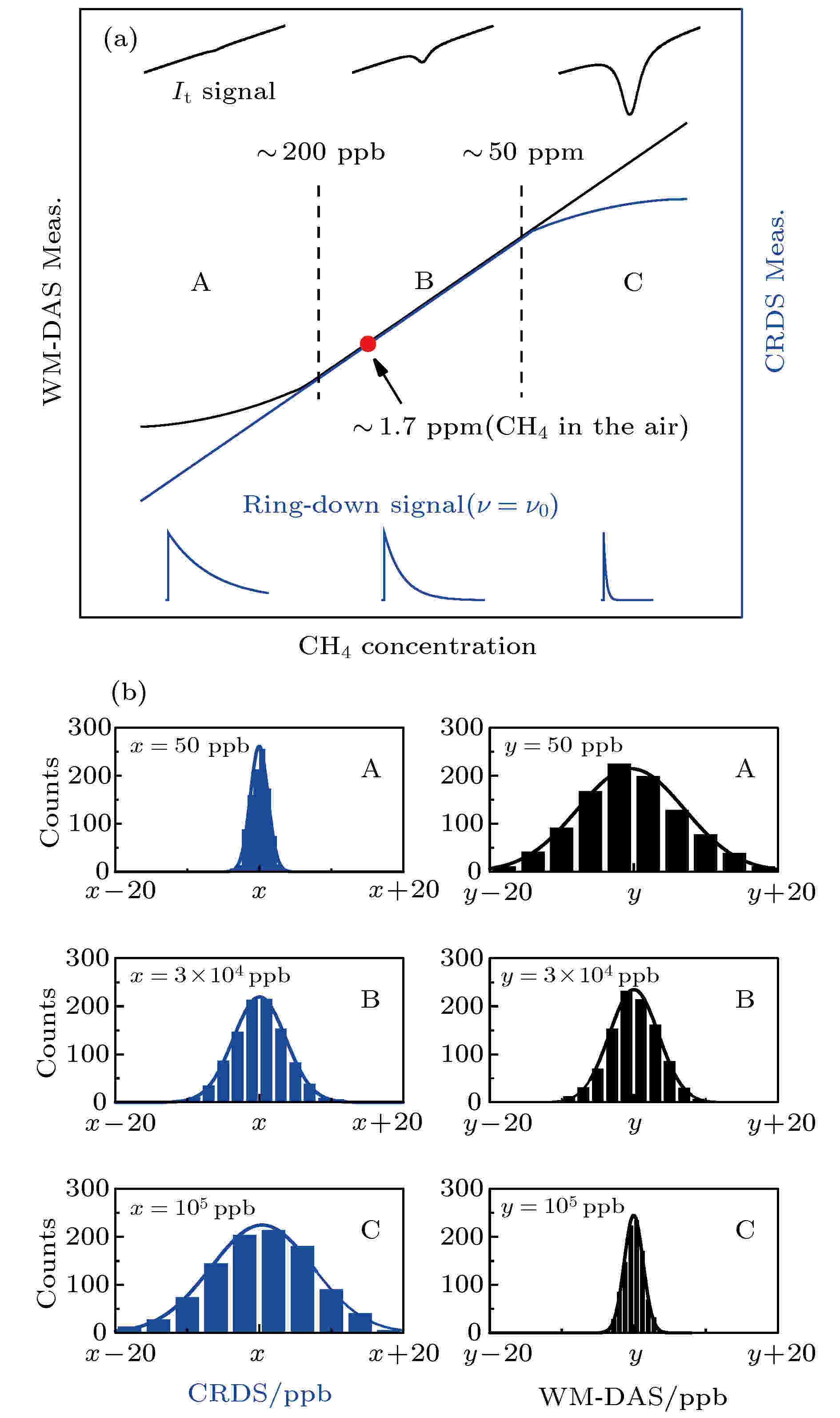 图 5 (a) 两种方法的CH4量程对比; (b)两种方法在不同CH4浓度下的直方图
图 5 (a) 两种方法的CH4量程对比; (b)两种方法在不同CH4浓度下的直方图Figure5. (a) Comparison of measuring range of CH4 between the two methods; (b) histograms of two methods at different concentrations of CH4.
4.1.大气痕量气体CH4和CO2在线监测方案
如图6所示, 两种方法(WM-DAS和CW-CRDS)采取分时的方式实现大气痕量气体的在线监测. 一次完整的测量用时为T0, 约60 s. WM-DAS采用正弦波扫描激光电流(黑色)得到透射光It (蓝色), 其中, 正弦波周期Td为1 ms, 采集个数为1000. 实际中由于数据量较大, 因而每次采集100个并处理, 处理时间为td (约1.5 s), 采集10次共耗时约15 s, 浓度取10次测量的平均值. CW-CRDS采用三角波扫描激光电流的方式来改变激光波长, 得到周期性的、蕴含气体吸收的衰荡时间信号(红色), 周期为Tr (约14.5 s), 采集个数为3, 处理时间为tr (约1.5 s), 共计约45 s. 通过一个完整测量过程, 即可得到两种方法测得的气体浓度, 重复该测量过程即可实现两种方法在线监测气体浓度. 图 6 WM-DAS与CW-CRDS方法联合测量的时序图、激光电流(黑色实线)、透射光强It (蓝色实线)、衰荡时间(红色实线)
图 6 WM-DAS与CW-CRDS方法联合测量的时序图、激光电流(黑色实线)、透射光强It (蓝色实线)、衰荡时间(红色实线)Figure6. Time sequence diagram of WM-DAS and CW-CRDS, laser current (black solid line), transmitted light It (blue solid line), ring down time (red solid line).
2
4.2.大气中CO2和CH4连续监测结果
如图7(a)所示, 室外CO2平均浓度约420 ppm, 白天CO2浓度升高, 这可能与测量点附近机动车尾气排放、人类活动有关, 这与文献[28]测得的结果一致. 从图7(b)可看出, WM-DAS和CW-CRDS方法测得的浓度一致性较好, 两组数据的线性拟合相关度达到0.99. 室内CO2平均值高于室外且浓度变化快, 与人类活动关系更大. 两种方法的室内测量数据有一定差异, 这主要是因为分时测量的方式使两种方法存在一定的测量延迟, 浓度快速变化时延迟更明显, 这种差异可以通过优化硬件和程序进一步减小.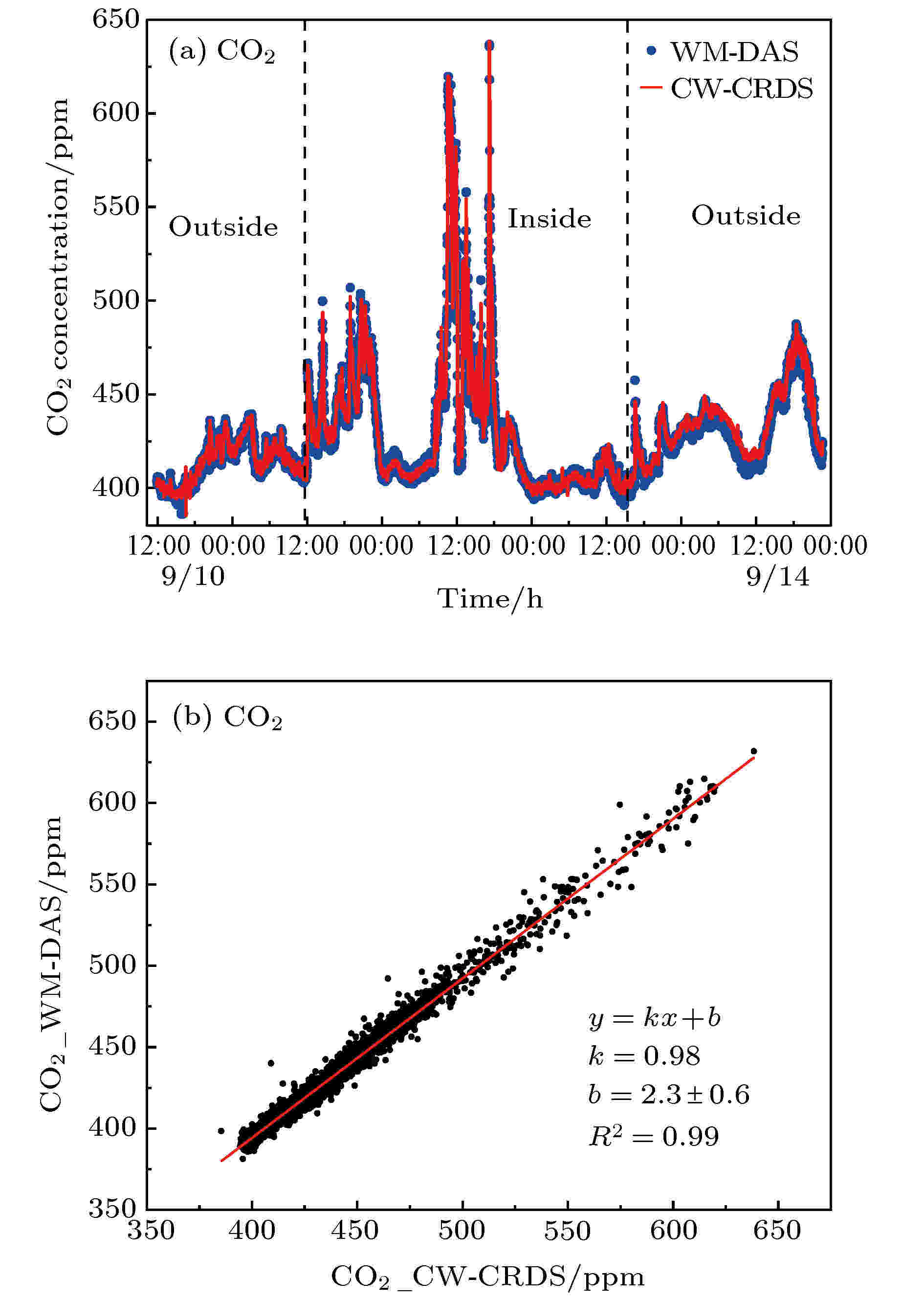 图 7 (a) 两种方法测量的大气中CO2浓度; (b) 两种方法测量数据的线性拟合
图 7 (a) 两种方法测量的大气中CO2浓度; (b) 两种方法测量数据的线性拟合Figure7. (a) CO2 in atmosphere measured by the two methods; (b) linear fitting of the data measured by the two methods.
如图8(a)所示, 室外CH4平均浓度在1.7 ppm左右, 这与文献[29]测得的结果一致. 两次CH4浓度升高均在0点以后, 这可能与土壤微生物活动有关[30], 而2019年9月17日18点到22点也有升高, 这可能与周围机动车排放有关. 从图8(b)可看出, WM-DAS与CW-CRDS方法测得的浓度一致性较好, 两组数据的线性拟合相关度达到0.994.
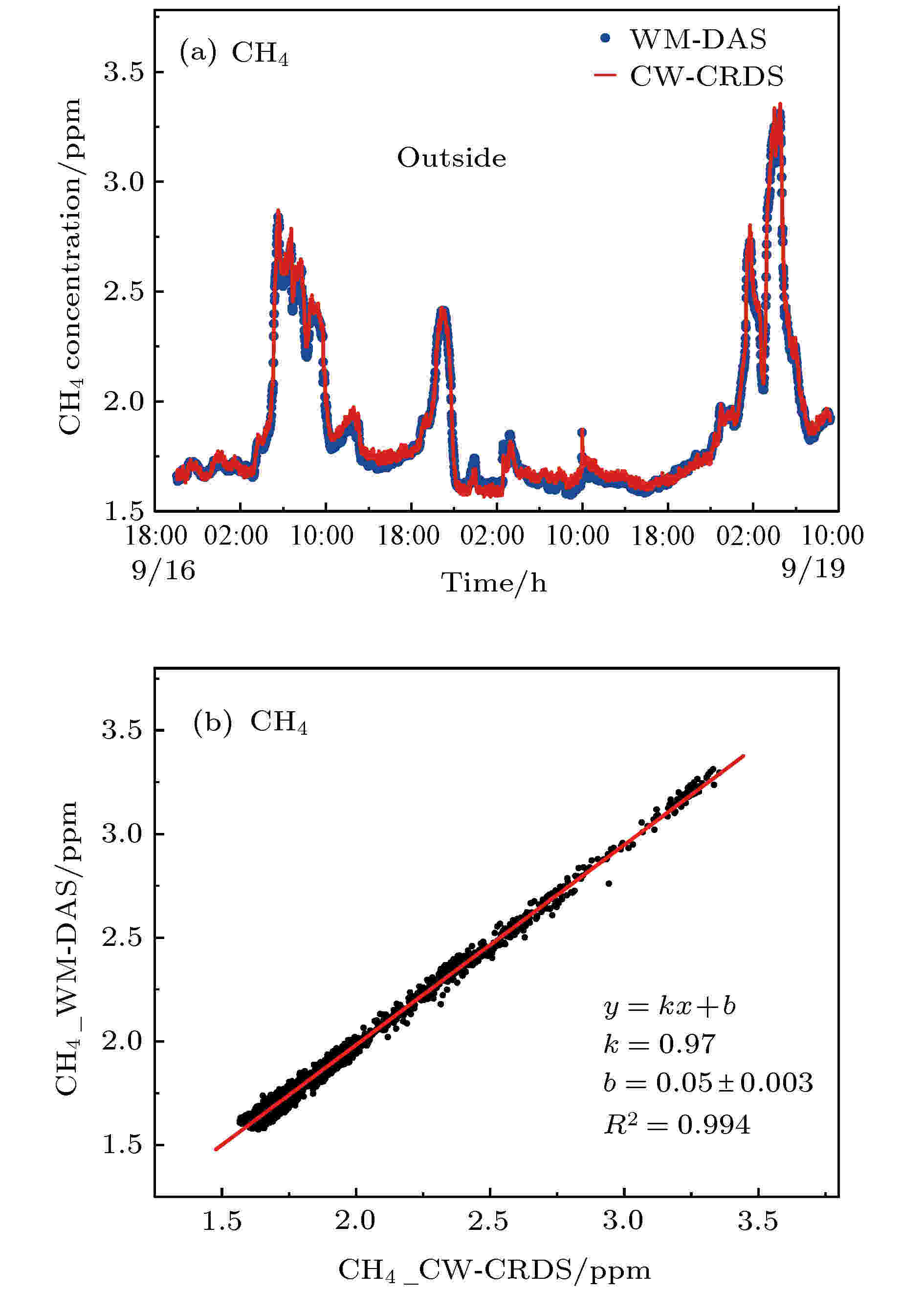 图 8 (a) 两种方法测量的大气中CH4浓度; (b) 两种方法测量数据的线性拟合
图 8 (a) 两种方法测量的大气中CH4浓度; (b) 两种方法测量数据的线性拟合Figure8. (a) CH4 in atmosphere measured by the two methods; (b) linear fitting of the data measured by the two methods.
2
4.3.WM-DAS的检测限
为了进一步评价两种方法的测量下限, 在相同的条件下, 分别对WM-DAS和CW-CRDS进行了Allan方差[31]分析, 其中, CW-CRDS采用固定中心波长的测量方式. 如图9所示, 积分时间约50 s时(固定波长下的衰荡时间采集速度约为0.02 s, 50 s相当于平均2500次), 基于CW-CRDS的CO2检测限达35 ppb, CH4检测限达0.7 ppb, 这是与McHale等[14] (1.5 ppb, 30 s)以及孙丽琴等[15] (1 ppb)检测限相一致, 这验证了本文CW-CRDS测量结果的可靠性. 积分时间约200 s时, 基于WM-DAS的CO2检测限可到170 ppb, CH4检测限可到1.5 ppb. 这说明长光程WM-DAS方法的检测限已接近CW-CRDS. 图9所示的CW-CRDS结果是在中心波长处测量得到的, 而实际测量中为了避免空腔衰荡时间的波动影响, 需扫描气体吸收谱线(约14.5 s)再经过光谱拟合得到气体浓度, 因而达到检测限所需的积分时间远大于WM-DAS. 图 9 两种方法测量的Allan方差 (a) CO2; (b) CH4
图 9 两种方法测量的Allan方差 (a) CO2; (b) CH4Figure9. Allan variance measured by the two methods: (a) CO2; (b) CH4.
